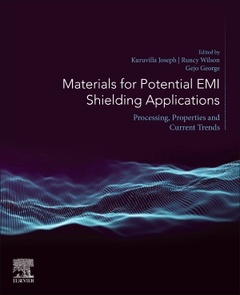Description
Materials for Potential EMI Shielding Applications
Processing, Properties and Current Trends
Coordinators: Joseph Kuruvilla, Wilson Runcy, Gejo George
Language: English
Subjects for Materials for Potential EMI Shielding Applications:
Keywords
Absorption; applications; Biodegradable; Biodegradable polymer; Biopolymers; Blends; Carbon allotropes; Carbon fiber; Carbon fiber-reinforced plastics; Carbon fiber-reinforced polymers; Carbon materials; Cellulose; Cement-based composites; Ceramic matrix composites; Characterization; Chitosan; Composite; Composite materials; Composite shield; Composites; Conducting polymer; Conducting polymer blends; Conducting polymers; Conductive carbon; Conductive fibers; Conductive fillers; Conductive textiles; Elastomers; Elastomers and Nanocomposites; Electrical conductivity; Electromagnetic compatibility; Electromagnetic interference; Electromagnetic interference shielding; Electromagnetic Interference Shielding; Electromagnetic radiation; Electromagnetic shielding; EMI; EMI applications; EMI shielding; EMI shielding effectiveness; EMI shielding materials; EMI shielding properties; Ferrites; Foams; High-temperature microwave characterization; Hybrid; Hybrid composites; Hybrid nanoparticles; Inherently conducting polymers; Magnetic properties; Magnetites; Mechanical and metallurgical properties; Metal alloy; Metal coating; Metal oxide-based nanomaterials; Metal shields; Metal wire mesh; Metal-based nanomaterials; Metal-organic framework; Metamaterials; Microstructure; Microwave; Modeling approach; MXene phase; Nanobifiller; Nanocarbon; Nanocomposite; Nanofillers; Nanomaterials; Nanoparticles; Nanotubes; Nanowires; Polarization; Polyaniline; Polymer; Polymer blends; Polymer composites; Polymer-based nanocomposites; Porous materials; Processing; Reflection; Reflection loss; SE test; Shielding effectiveness; Shielding efficiency; Shielding fabrics; Shielding mechanism; Shielding theory; Simulation; Sustainable; Syntactic foams; Table of Contents; Thermoplastics; Thermosets; Thermosetting polymers; X band
412 p. · 21.4x27.6 cm · Paperback
Description
/li>Contents
/li>Readership
/li>Biography
/li>Comment
/li>
Materials for Potential EMI Shielding Applications: Processing, Properties and Current Trends extensively and comprehensively reviews materials for EMI shielding applications, ranging from the principles to possible applications and various types of shielding materials. The book provides a thorough introduction to electromagnetic interference, its effect on both the environment and other electronic items, various materials that are used for electromagnetic interference shielding applications, and its properties. It explains the mechanism behind EMI shielding, the methods by which EMI SE of a given material is estimated, and the different fabrication methods currently employed for fabricating EMI shielding materials.
Final sections focus on the theoretical background of EMI shielding and shielding mechanisms. This theoretical background is extended to the physics of EMI shielding, wherein the physics behind mechanism of shielding is explained.
1. Introduction 2. Theory of EMI shielding 3. EMI shielding disclosed through virtual and physical experiments 4. Significance of naturally derived materials for potential EMI shields 5. Thermoplastic polymer composites for EMI shielding applications 6. EMI Shielding Materials Based on Thermosetting Polymers 7. Metal embedded matrices for EMI shielding 8. Elastomer based materials for EMI shielding applications 9. Polymeric blends as EMI shielding materials 10. Biodegradable polymeric materials for EMI shielding 11. Nanomaterials with Potential EMI Shielding Properties 12. Carbon based nanocomposites for EMI Shielding –Recent Advances 13. Carbon fibers-reinforced Composites for EMI shielding 14. Hybrid Polymer Nanocomposites with EMI Shielding Applications 15. Carbon Fiber Reinforced Polymer – Metal Wire Mesh Hybrid Composite for Electromagnetic Interference Shielding 16. Conducting Polymer Composites: An Efficient EMI Shielding Material 17. EMI shielding textile materials based on conducting polymers 18. Porous materials for EMI shielding 19. Electromagnetic Shielding of Ceramic Materials 20. Cement based EMI shielding materials 21. EMI Shielding of Metals, Alloys and Composites 22. EMI shielding textile materials 23. High Temperature Electromagnetic shielding material
Scientists and researchers working in industries, R&Ds, academicians, and PhD and master students in chemical engineering, materials chemistry, and materials science
Kuruvilla Joseph is a Professor in the Department of Chemistry at the Indian Institute of Space Science and Technology, Thiruvananthapuram, India. His research areas includes nanomaterials and nanocomposites, polymer blends and composites, synthesis of polymers from natural resources, green materials and biocomposites, aging and degradation, and development of biosensors.
Dr. Wilson is an assistant professor in the Department of Chemistry, St. Cyril’s College, Kerala, India. He obtained his PhD in Chemistry from Mahatma Gandhi University, Kottayam, India. He has written several publications in international journals and conference proceedings. He has also co-edited two books one titled “Transport Properties of Polymeric Membranes and the other titled “Materials for Potential EMI Shielding Applications: Processing, Properties and Current Trends published by Elsevier. He has also conducted research work at Katholieke Universiteit Leuven, Belgium. Dr. Runcy has also almost two years of industrial experience as a junior scientist at the Corporate R&D Centre, HLL Lifecare Limited, a Government of India Enterprise, in the area of synthesis of green polymers. His current research interests include polymer nanocomposites for membrane applications, synthesis of biodegradable polymers for medical applications, and development of high quality EMI shielding material.
Dr. George obtained his PhD in Chemistry from Kalasalingam University, Tamil Nadu, India in 2014, specializing in the area of commingled natural fiber composites. He published several articles in high-impact journals (Composite Part A, Composite Part B, Carbon, Scientific Reports etc.) and wrote chapters for several books. He has two and a half years of experience as a junior scientist at the Corporate R&D Centre, HLL Lifecare Limited, a Government of India Enterprise, in the area of graphene/natural rubber latex nanocomposites for contraceptive applications. Dr. George also completed two years of p
- Focuses on the different types of available EMI shielding, their applications, processing, characterization, and the mechanism behind their shielding
- Discusses how to incorporate EMI shielding with low cost, low density and high strength
- Provides an understanding and clarifies both elementary and practical problems relating to EMI shielding materials




